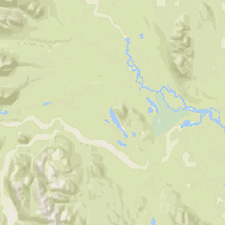Bear Glacier & Bear Glacier Lagoon

Just outside of Seward, Bear Glacier flows down from the Harding Icefield—the largest icefield entirely contained within the United States—into a long, narrow lagoon. It’s the largest glacier in Kenai Fjords National Park, stretching 12 miles from its origin. Unlike the park’s tidewater glaciers that meet the ocean directly, Bear Glacier ends in a protected lake formed between the glacier and its terminal moraine.
The lagoon itself is striking. Calm and shielded from ocean swell, it’s filled with massive icebergs, many much larger than those found near tidewater glaciers elsewhere in the park. Some are the size of small buildings. Visitors paddling in the lagoon often describe it as surreal: ice stacked like sculpture, seals popping up between floes, and the steady sound of meltwater trickling through rock and ice.
Calving events at Bear Glacier can send large waves rippling across the lagoon, and the icebergs themselves (many with 90% of their mass hidden underwater) can roll or flip without warning. These dynamic conditions are part of what makes the area so compelling, but also unpredictable. That’s why it’s recommended to explore with a local guide who understands how to read the ice, the weather, and the landscape as it shifts. The lagoon is also shaped by hidden forces beneath the surface. In addition to the main lagoon, smaller glacier-dammed lakes can form behind, beneath, or even inside the glacier. These lakes occasionally burst through their icy walls in sudden floods—called glacial lake outburst floods, or jökulhlaups—powerful reminders of the energy flowing through this seemingly still environment.
Here’s how you can experience Bear Glacier Lagoon yourself.

Paddle Among Icebergs
At the mouth of Bear Glacier, the protected waters of the lagoon offer one of Alaska’s more unusual paddling experiences. Liquid Adventures, a local outfitter based in Seward, leads trips by kayak or inflatable paddleboard, weaving through the ever-shifting maze of ice. The lagoon is sheltered (minus the occasional wind coming off the glacier), making it navigable for newer paddlers. Though experience helps, especially for paddleboarding.
Getting there is part of the adventure. You can take a water taxi up the coast of Resurrection Bay, often spotting puffins or sea otters along the way. Or opt for the helicopter access: a short but scenic flight over the Chugach Mountains, the Harding Icefield, and the glacier itself, before landing near the lagoon. Once there, you’ll suit up in a drysuit and head onto the water with your guide. Expect to spend about five hours round trip.

Flightseeing: Bear Glacier from the Air
Aerial tours offer a completely different perspective on Bear Glacier and the surrounding fjords and peaks. The full length of the glacier comes into view, and from above, you can see the deep blue crevasses and patterns formed by decades of ice movement. Marathon Helicopters, AA Seward Air Tours, and Alaska Helicopter Tours all offer flights over Bear Glacier. The helicopters offer landings on the north eastern side of the lagoon. AA Seward Air Tours has a special permit to land on the icefield itself!
Stay: Overnight Near Bear Glacier
While Bear Glacier is remote, it is possible to stay overnight—whether you're looking for a cozy basecamp with a hot tub or planning to pitch a tent on the beach. Here are a few options:
The Iceberg Inn
If you're looking for comfort in the wilderness, The Iceberg Innoffers a one-bedroom, off-grid yurt set on the shores of the lagoon. Accessible only by helicopter from Seward, you'll find a queen bed, small kitchenette, and seating area. Outside, there’s a deck and a hot tub overlooking the lagoon. It's quiet, private, and ideal for couples or small families looking for a remote, immersive stay. Meals are self-catered, and a local host is nearby if needed.
Guided Overnight Camping & Kayak Trip with Liquid Adventures
Liquid Adventures offers a two-day guided paddleboarding and kayaking trip that includes overnight camping near the glacier. Gear, meals, and drysuits are provided. The trip begins with transport (either by water taxi or helicopter), and once at the lagoon, you'll spend the day navigating among icebergs before setting up camp on a remote beach. In the evening, there’s time to explore the shoreline or just take in the solitude. It’s a great option if you want the full backcountry experience without managing all the logistics yourself.
Camping on Your Own
Independent camping is allowed near Bear Glacier Lagoon, typically on the outer beach or moraine well away from the glacier face. There are no formal campsites or facilities, and visitors must be completely self-sufficient. The National Park Service recommends camping at least two miles from the glacier’s face and well above the high-water line to avoid risks from calving waves or sudden water level rises. Visit the National Park Service website for more details.
Elopements & Wedding Photography
Bear Glacier has become a popular spot for elopements, engagements, and private photo sessions—especially for couples looking for something intimate and off the beaten path. Helicopter access makes it possible to land on remote beaches or ridges with glacier backdrops and no one else around. Some operators, like Marathon Helicopters and Iceberg Inn offer elopement packages and even officiant services. The setting—whether you’re standing among wildflowers, overlooking floating icebergs, or landing near the glacier itself—makes for stunning photos and a uniquely Alaskan kind of celebration.

Want to See More?
Bear Glacier has changed dramatically over the years—and continues to. You can explore time-lapse images and historic comparisons in AlaskaGlaciers: Then & Now to see how the landscape has evolved and what the future might hold for this part of Kenai Fjords.


